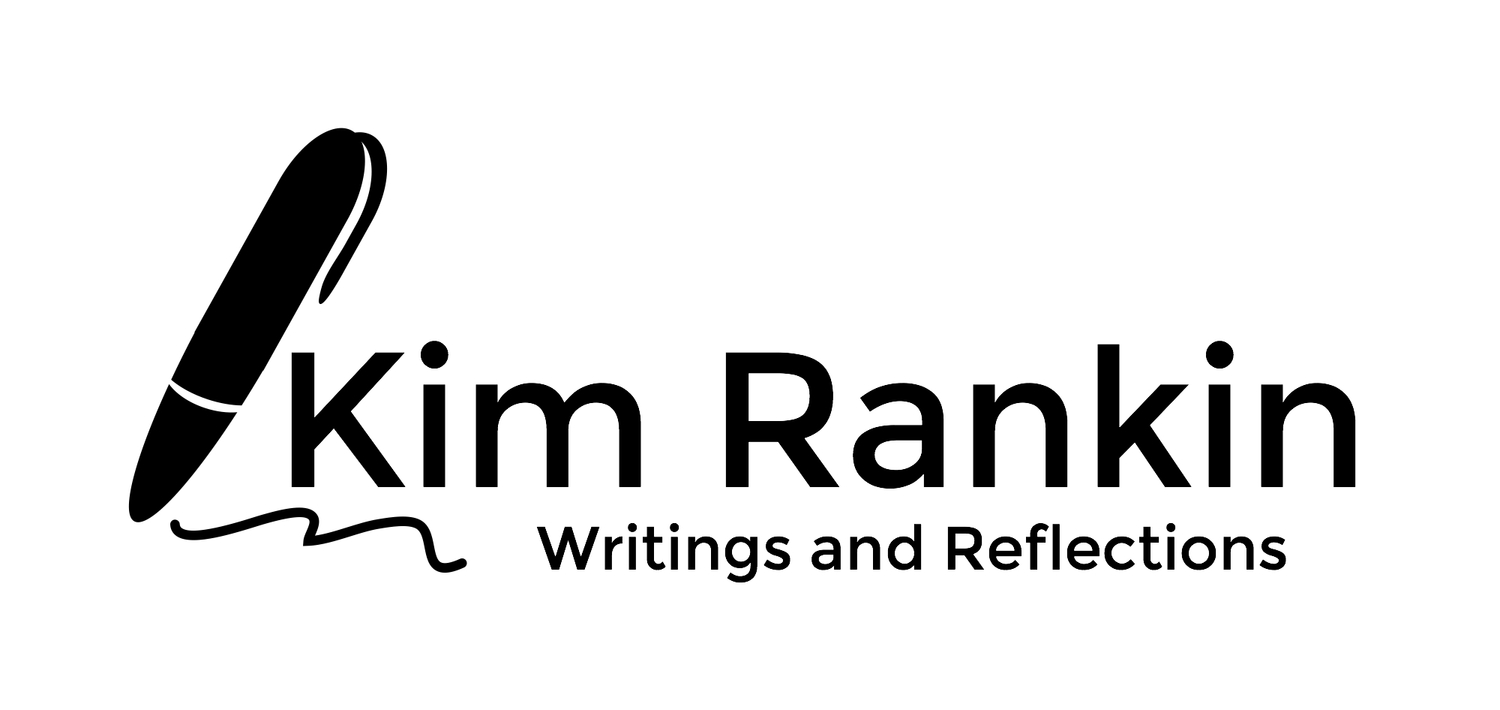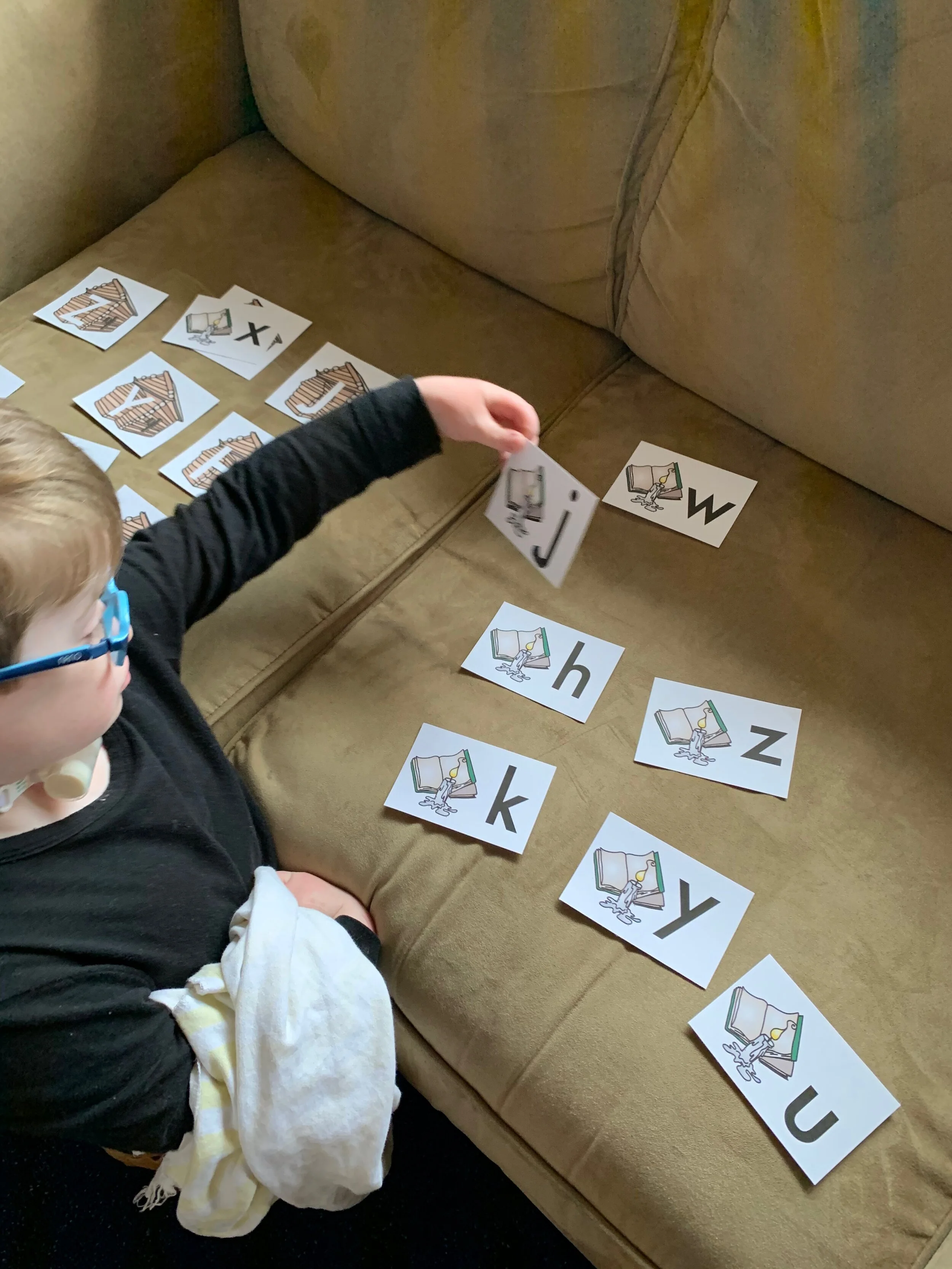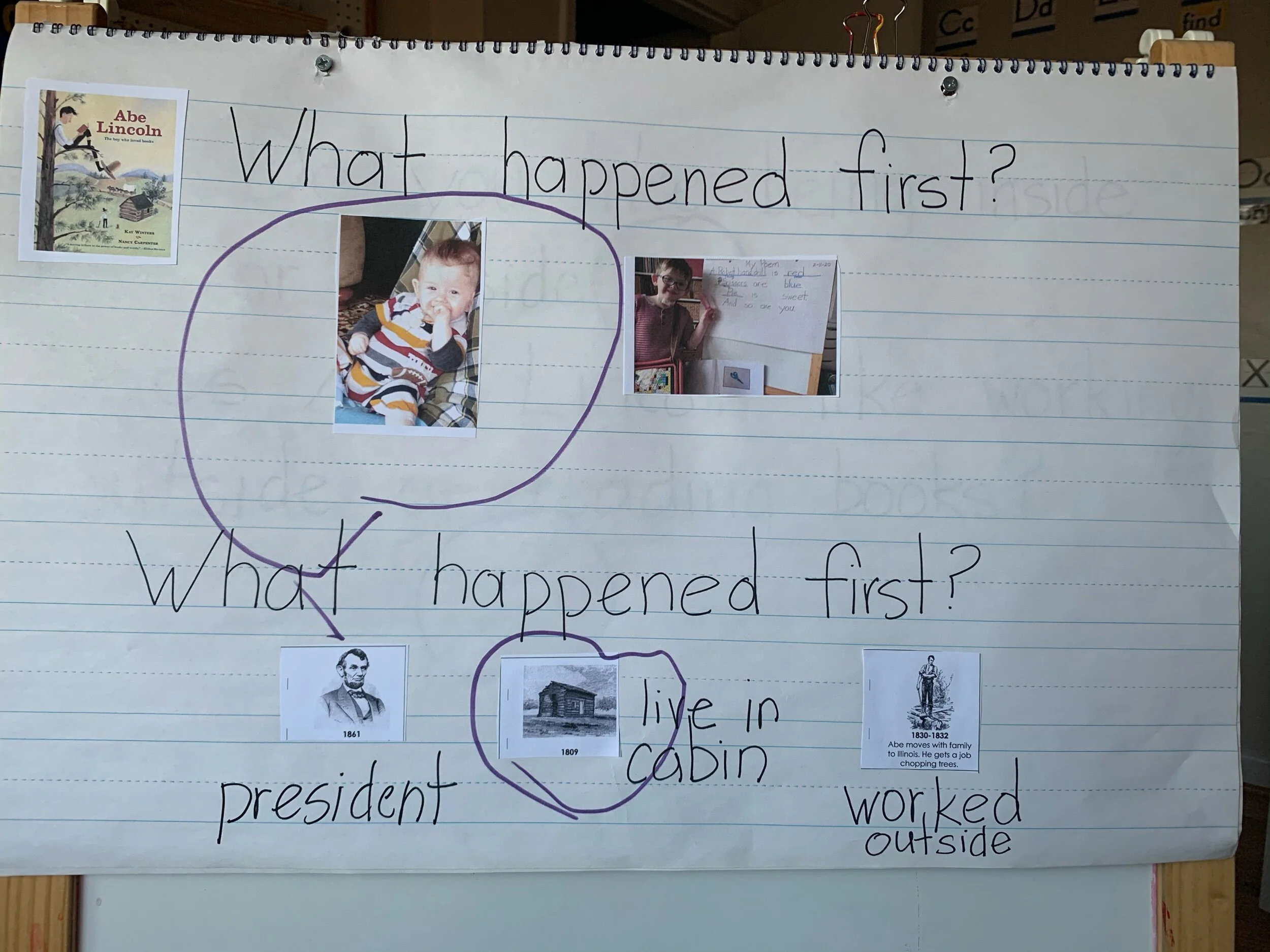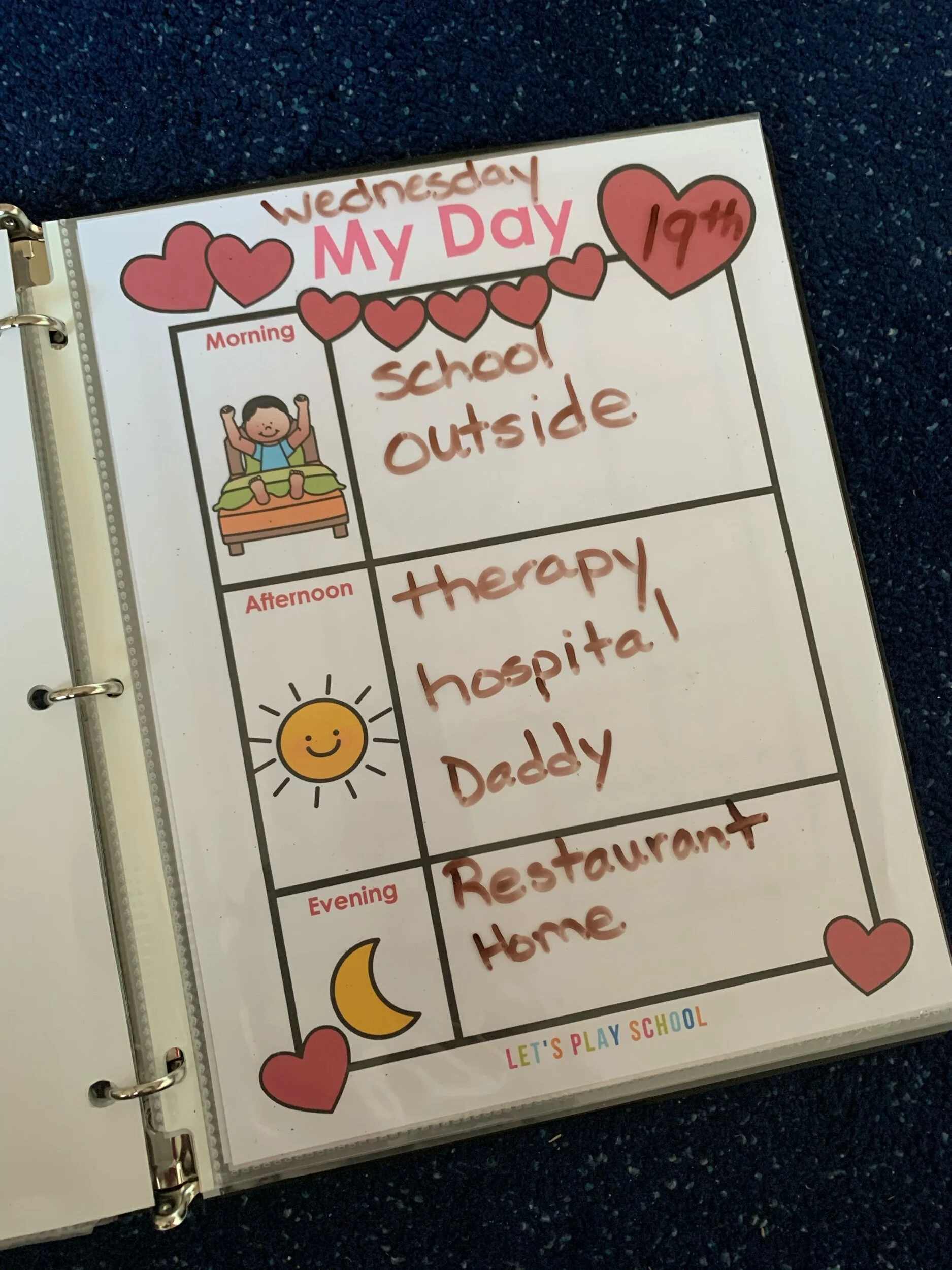End of the Week Peek into Comprehensive Literacy at Home: Abe Lincoln
In honor of President’s Day this week, I based our literacy learning on the book, Abe Lincoln: The boy who loved books by Kay Winters and Nancy Carpenter. I am implementing the recommendations of Drs. Erickson and Koppnhaver’s book, Comprehensive Literacy for All, Teaching Students with Significant Disabilities to Read and Write. I focus on five areas of instruction: alphabet knowledge and phonological awareness, shared reading, shared writing, independent reading, and independent writing.
Alphabet Knowledge and Phonological Awareness:
We are in our fourth cycle of Enhanced Alphabet Knowledge Instruction. I provide a mini lesson each day; our letters for instruction this week were X, W, O, K, and H. I continued with the alphabet picture books and song and rhyme books that I mentioned last week. (Find last week’s literacy sneak peak here.)
I use two additional activities daily to review a larger number of letters and their phonetic sounds. I have seen Nathaniel’s retention of letters and sounds improve significantly by offering these additional layers of review. The first uses our sight word wall. I chose five different letters per day and have them written on cards. This month our cards are heart shaped. The Enhanced Alphabet Knowledge lesson is short, usually less than ten minutes, but this activity is even faster. We complete all five letters in ten minutes or less. Nathaniel picks a letter card, finds the letter on his AAC device Qwerty keyboard to say its name, and then places the letter card in its “house” on our word wall. We quickly do the gross motor sign that we use for the letter sound and go over any sight words that start with that letter. We are using the Dolch sight word lists and working on the pre-primer level.
A second activity we do regularly is lower and capital letter matching. To go with our Lincoln theme, I made cards with log cabin, book and candle graphics. Nathaniel placed each candle and book lower case letter card with its corresponding log cabin capital letter card. He loved the idea of putting a book and candle in the cabin for Abe to read. “Repetition with variety” is one of the principles that Erickson and Koppenhaver encourage in literacy instruction. It has been fun to see how changing the graphics frequently and connecting them to our week’s story keeps Nathaniel’s interest in this task.
Shared Reading/Reading Comprehension:
I have been trying to improve my skills in teaching reading comprehension. I mentioned a few weeks ago that Nathaniel has strong receptive language and comprehension skills. No excuse to slide on instruction. I need to continue to grow those for him. Comprehensive Literacy for All encourages the use of anchor-read-apply charts as a conventional literacy instruction strategy to grow reading comprehension. I worked hard this week to do that anchor step.
On Monday I asked Nathaniel, “What do you love?” He quickly offered a variety of things: video games and controllers, Mario Kart, watching movies, guns, and his brother’s gun video game. (Oh yes, guns. And we aren’t done with them yet. The rifles in the book illustrations meant we talked about guns a lot this week!) We then read the book to answer the question, “What does Abe Lincoln love?”
On Tuesday I asked, “How do you help at home?” Together we came up with a list of things he does: feed dog, wash dishes, pick up toys, and work in yard. We read our story to answer the question, “How does Abe help at home?”
On Wednesday I glued two photos of Nathaniel on our chart, one as a baby and one taken last week. I asked him, “What happened first?” We talked about a timeline and how some life events come before others. Nathaniel circled the photo that came first in his life. I then glued three photos from Abe Lincoln’s life on our chart. We read the book to answer the question, “What happened first (in Abe Lincoln’s life)?
On Thursday I anchored our reading for the day by asking Nathaniel if he enjoyed being inside or outside and offered core words for him to pick from. We read our book to answer the question, “Does Abe Lincoln like working outside or reading books?”
So…. readers with experience teaching conventional literacy to complex communicators, how did I do with my anchor question and purposeful reading? Offer feedback and help in the comments please!
By the way - I use this chart and Ikea’s $15 easel for all chart writing. My husband put two screws, spaced the width of the chart holes and with the heads protruding, into the top bar of the easel. Super easy way to hang a chart in the home environment.
Other books we shared this week included the titles below. There were no repeating lines to use for completion with an AAC device, but a lot of great content for commenting and asking questions.
P is for President by Wendy Lewiston
My Country, Little Word Social Studies
Wolves by Gail Gibbons
President’s Sticker book that was from my older kids. It ended with President Bill Clinton!
Shared Writing:
We wrote a predictable chart titled, Things That Get Lost using the sentence starter, “Where is my _____?” Nathaniel has been using question marks in his independent writing recently, and I wanted to provide some instruction on the difference between a sentence and a question. This sentence starter also let us work with our new sight words for the week: WHERE and MY.
We solicited help from some family members to complete our chart. Thank you to those who answered our texts and sent a word and then also a photo for our book! I decided to challenge Nathaniel’s understanding of our literature for the week by asking him what Abe Lincoln might say to finish the sentence “Where is my____?” Nathaniel instantly signed BOOK. We added Abe’s contribution to our chart.
We used our predictable chart to find the letter each day. Graphing the number of times a letter appears takes just a moment and sneaks in a bit of math instruction. We found our sight word MY in each sentence, and we discussed beginning a question with a capital letter.
A second shared writing activity we enjoyed was to imitate some writing from our story about Abe Lincoln. Kay Winter’s tale is poetic, descriptive, and beautiful. She writes of the Lincoln family’s move to Little Pigeon Creek: “Bears growled, wolves howled, panthers screamed. Abe shivered.”
I typed these statements and analyzed the structure with Nathaniel. Animal + noise repeated three times. Person + action one time. I used color coding and blank lines to help Nathaniel visualize how to write something similar. He immediately offered the author’s first animal, “bears,” and then hit the growl sound that we have programmed into his AAC device. I wrote it down. When he said "wolf” to begin our second line, I told him that no, this was not expressive language work. I was not asking him to simply repeat what we had read. Rather, I wanted him to come up with his own animals and noises.
Nathaniel provided “snakes” and the /s/ sound using his AAC device. He said “foxes “ next, but was stuck on the sound. I didn’t know what sound a fox made either! We listened to fox sounds on You Tube. We decided to call it a bark.
I filled in Nathaniel’s name to begin the last line. I asked, “What would you do if a bear growled and a snaked hissed and a fox barked?” He shaped his hands into a make believe gun and FIRED at our chart by jetting his arms out and falling back onto the couch from the recoil. BOOM! This kid is writing some amazing stories by following the models of children’s book authors. He is so much fun to teach!
A third shared writing activity that we do every day is to write our daily plan. We do this each morning as part of our opening time and notebook time together. I leave the day’s plan as written so that the following day we can review what we did yesterday. This a not only a great opportunity to demonstrate sounding out the first letter of a word as I write, but a practical use of the days of the week and dates in the month. I model those and our activities on Nathaniel’s device as I write. The sweet printable is from Let’s Play School Fundamentals collection. I have it in a page protector and we use a dry erase marker.
Independent Reading:
Nothing really new to share here. Nathaniel spent a second week pouring over the two books I mentioned last week. He chose them every day and read them for the entire twenty minutes. But he voluntarily put them in the library return pile on Friday afternoon so it will be interesting to see what snags his interest next week.
Independent Writing:
On Monday I told Nathaniel that he was going to write a report on Abe Lincoln. I was inspired by a post from Karen Owens of the Facebook page, We Speak Podd describing the biography reports her children recently completed. This was the perfect week to try a biography report as a tie in with President’s Day and our book of the week.
We visited the Lincoln Boyhood National Memorial last May when visiting Nathaniel’s older brother. I felt this personal connection to writing his report would be the best place to start. We reviewed pictures from our trip to the memorial on my laptop. Nathaniel picked one to write about. Nathaniel currently uses an iPad and Google documents to do an independent writing activity like this. I recently purchased the Keedogo Plus app to see what he can do with a child friendly keyboard and word prediction. The app worked well within Google documents. Nathaniel loved being able to select whole words.
We wrote about a picture from our visit to the Lincoln cabin again on Tuesday. Nathaniel noticed a wolf skin in the background of the picture. Using his AAC device, he told me he wanted to write about that wolf. Well, that wolf and a gun. So he wrote about a wolf and gun and his dad and his brother. While he never used the word “hunting,” this was clearly Nathaniel’s first hunting story. I helped with the writing process by occasionally slowing him down to consider beginning letter sound of a word he indicated with his AAC device that he wanted to use. I instructed how to select the right word from the word prediction choices. On Wednesday, he wanted to write about wolves again so we searched for a picture on the internet and he wrote in the same fashion as the other two days. He wrote that the wolf had two babies and that the wolf got a moose.
I steered Thursday and Friday’s independent writing time away from wolves and guns and hunting and towards Lincoln again. I had a sticker book about Lincoln’s life in my file folder on presidents. I must have picked it up last spring at the memorial. The stickers prompted Nathaniel to pick specific moments of Lincoln’s life to write about. Again he wrote using Google documents. On Friday, he wrote a page for his report and we made a cover page. We have been working on the order of letters in Nathaniel’s name, and I felt asking him to copy ABE LINCOLN would be a good opportunity to review the concept that letters have to go in a specific order for everyone’s name. I offered Nathaniel the option of letter stamps or the iPad to create his cover page. He chose letter stamps. Stamping ten letters in a specific order was a challenge for Nathaniel, but he persevered. He drew a picture of Lincoln and added a sticker for his head.
Earlier in the week, we watched a brief video tour of the Lincoln Memorial in Washington DC. Nathaniel wanted to add that sticker to the front of his report too. He told me “man in sit” using his AAC device. Though he offered this additional bit of information, I did not add it to the report. I try very hard to not write on or over Nathaniel’s independent writing. Because I let his writing stand as is, the finished product is never a complete picture of all the literacy learning that takes place while Nathaniel is writing. The process is layered, rich, and collaborative. Giving Nathaniel the chance to write using the whole alphabet and word prediction gives me countless opportunity for instruction.
The final and very important step for finishing the report was to lay out everything Nathaniel had written and let him decide on the order it should go for his report. We stapled and taped the edges. We published his work by showing it to Dad.
Thanks for following along with our learning! I hope these peeks into my classroom enrich your own literacy instruction. Be sure to leave a comment or ask a question.















